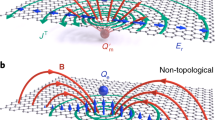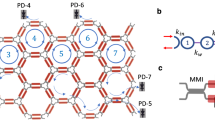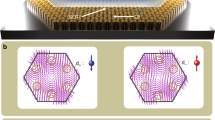Abstract
Topological features—global properties not discernible locally—emerge in systems ranging from liquid crystals to magnets to fractional quantum Hall systems. A deeper understanding of the role of topology in physics has led to a new class of matter—topologically ordered systems. The best known examples are quantum Hall effects, where insensitivity to local properties manifests itself as conductance through edge states that is insensitive to defects and disorder. Current research into engineering topological order primarily focuses on analogies to quantum Hall systems, where the required magnetic field is synthesized in non-magnetic systems. Here, we realize synthetic magnetic fields for photons at room temperature, using linear silicon photonics. We observe, for the first time, topological edge states of light in a two-dimensional system and show their robustness against intrinsic and introduced disorder. Our experiment demonstrates the feasibility of using photonics to realize topological order in both non-interacting and many-body regimes.
This is a preview of subscription content, access via your institution
Access options
Subscribe to this journal
Receive 12 print issues and online access
$209.00 per year
only $17.42 per issue
Buy this article
- Purchase on Springer Link
- Instant access to full article PDF
Prices may be subject to local taxes which are calculated during checkout




Similar content being viewed by others
References
Klitzing, K. V., Dorda, G. & Pepper, M. New method for high-accuracy determination of the fine-structure constant based on quantized Hall resistance. Phys. Rev. Lett. 45, 494–497 (1980).
Tsui, D. C., Stormer, H. L. & Gossard, A. C. Two-dimensional magnetotransport in the extreme quantum limit. Phys. Rev. Lett. 48, 1559–1562 (1982).
König, M. et al. Quantum spin Hall insulator state in HgTe quantum wells. Science 318, 766–770 (2007).
Girvin, S. M. in The Quantum Hall Effect: Novel Excitations and Broken Symmetries (eds Comtet, A., Jolicoeur, T., Ouvry, S. & David, F.) Course 2, 53–175 (Les Houches Lectures Session LXIX: Topological Aspects of Low Dimensional Systems, Springer, 2000).
Cooper, N. Rapidly rotating atomic gases. Adv. Phys. 57, 539–616 (2008).
Lin, Y., Jiménez-García, K. & Spielman, I. Spin–orbit-coupled Bose–Einstein condensates. Nature 471, 83–86 (2011).
Aidelsburger, M. et al. Experimental realization of strong effective magnetic fields in an optical lattice. Phys. Rev. Lett. 107, 255301 (2011).
Dalibard, J., Gerbier, J., Juzeliūnas, F. & Öhberg, G. Artificial gauge potentials for neutral atoms. Rev. Mod. Phys. 83, 1523–1543 (2011).
Hafezi, M., Demler, E. A., Lukin, M. D. & Taylor, J. M. Robust optical delay lines with topological protection. Nature Phys. 7, 907–912 (2011).
Haldane, F. & Raghu, S. Possible realization of directional optical waveguides in photonic crystals with broken time-reversal symmetry. Phys. Rev. Lett. 100, 013904 (2008).
Wang, Z., Chong, Y., Joannopoulos, J. D. & Soljacic, M. Observation of unidirectional backscattering-immune topological electromagnetic states. Nature 461, 772–775 (2009).
Rechtsman, M. C. et al. Strain-induced pseudomagnetic field and photonic Landau levels in dielectric structures. Nature Photon. 7, 153–158 (2013).
Fang, K., Yu, Z. & Fan, S. Realizing effective magnetic field for photons by controlling the phase of dynamic modulation. Nature Photon. 6, 782–787 (2012).
Hafezi, M. & Rabl, P. Optomechanically induced non-reciprocity in microring resonators. Opt. Express 20, 7672–7684 (2012).
Umucalilar, R. & Carusotto, I. Artificial gauge field for photons in coupled cavity arrays. Phys. Rev. A 84, 043804 (2011).
Khanikaev, A. et al. Photonic topological insulators. Nature Mater. 12, 233–239 (2013).
Bernevig, B. & Zhang, S.-C. Quantum spin Hall effect. Phys. Rev. Lett. 96, 106802 (2006).
Kraus, Y., Lahini, Y., Ringel, Z., Verbin, M. & Zilberberg, O. Topological states and adiabatic pumping in quasicrystals. Phys. Rev. Lett. 109, 106402 (2012).
Xia, F., Sekaric, L. & Vlasov, Y. Ultracompact optical buffers on a silicon chip. Nature Photon. 1, 65–71 (2007).
Little, B. E. et al. Ultra-compact Si–SiO2 microring resonator optical channel dropping filters. IEEE Photon. Technol. Lett. 10, 549–551 (1998).
Melloni, A. & Martinelli, M. Synthesis of direct-coupled-resonators bandpass filters for WDM systems. J. Lightwave Technol. 20, 296–303 (2002).
Sakai, A., Fukazawa, T. & Baba, T. Estimation of polarization crosstalk at a micro-bend in Si photonic wire waveguide. J. Lightwave Technol. 22, 520–525 (2004).
Dumon, P. et al. Low-loss SOI photonic wires and ring resonators fabricated with deep UV lithography. IEEE Photon. Technol. Lett. 16, 1328–1330 (2004).
Vlasov, Y. & McNab, S. Losses in single-mode silicon-on-insulator strip waveguides and bends. Opt. Express 12, 1622–1631 (2004).
Xu, Q., Schmidt, B., Pradhan, S. & Lipson, M. Micrometre-scale silicon electro-optic modulator. Nature 435, 325–327 (2005).
Cooper, M. et al. Statistics of light transport in 235-ring silicon coupled-resonator optical waveguides. Opt. Lett. 35, 784–786 (2010).
Laughlin, R. Quantized Hall conductivity in two dimensions. Phys. Rev. B 23, 5632–5633 (1981).
Halperin, B. Quantized Hall conductance, current-carrying edge states, and the existence of extended states in a two-dimensional disordered potential. Phys. Rev. B 25, 2185–2190 (1982).
Morichetti, F. et al. Roughness induced backscattering in optical silicon waveguides. Phys. Rev. Lett. 104, 033902 (2010).
Waks, E. et al. Secure communication: quantum cryptography with a photon turnstile. Nature 420, 762 (2002).
Srinivasan, K. & Painter, O. Linear and nonlinear optical spectroscopy of a strongly coupled microdisk–quantum dot system. Nature 450, 862–865 (2007).
Englund, D. et al. Controlling cavity reflectivity with a single quantum dot. Nature 450, 857–861 (2007).
Faraon, A. et al. Coherent generation of nonclassical light on a chip via photon-induced tunneling and blockade. Nature Phys. 4, 859–863 (2008).
Dudin, Y. O. & Kuzmich, A. Strongly interacting Rydberg excitations of a cold atomic gas. Science 336, 887–889 (2012).
Peyronel, T. et al. Quantum nonlinear optics with single photons enabled by strongly interacting atoms. Nature 488, 57–60 (2012).
Acknowledgements
The authors thank J. Chen, K. Srinivasan, M. Lukin, A. Melloni, M. Fournier, G. Solomon and E. Waks for stimulating discussions and experimental help. M.H. thanks the Institute for Quantum Optics and Quantum Information (Innsbruck) for hospitality. This research was supported by a US Army Research Office Multidisciplinary University Research Initiative award (W911NF0910406) and the National Science Foundation through the Physics Frontier Center at the Joint Quantum Institute. Disclaimer: Certain commercial equipment, instruments or materials are identified in this paper to foster understanding. Such identification does not imply recommendation or endorsement by the National Institute of Standards and Technology, nor does it imply that the materials or equipment are necessarily the best available for the purpose.
Author information
Authors and Affiliations
Contributions
M.H. conceived the experiment. M.H., J.F., A.M. and J.M.T. designed the chips. M.H., S.M. and J.F. carried out the experiment and analysed the data. M.H. and J.M.T. wrote the manuscript. All authors contributed considerably.
Corresponding author
Ethics declarations
Competing interests
The authors declare no competing financial interests.
Supplementary information
Supplementary information
Supplementary information (PDF 889 kb)
Rights and permissions
About this article
Cite this article
Hafezi, M., Mittal, S., Fan, J. et al. Imaging topological edge states in silicon photonics. Nature Photon 7, 1001–1005 (2013). https://doi.org/10.1038/nphoton.2013.274
Received:
Accepted:
Published:
Issue Date:
DOI: https://doi.org/10.1038/nphoton.2013.274
This article is cited by
-
Detailed analysis of topological edge and corner states in valley-Hall-like photonic Kagome insulators
Applied Physics B (2024)
-
Realization of photonic p-orbital higher-order topological insulators
eLight (2023)
-
Sub-symmetry-protected topological states
Nature Physics (2023)
-
Observation of strong backscattering in valley-Hall photonic topological interface modes
Nature Photonics (2023)
-
Non-Abelian effects in dissipative photonic topological lattices
Nature Communications (2023)



